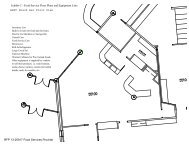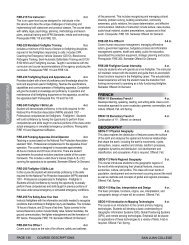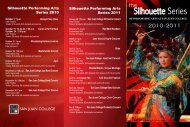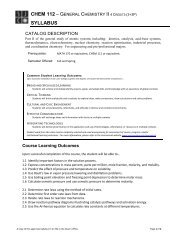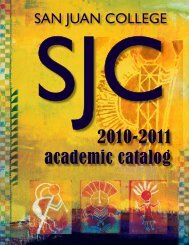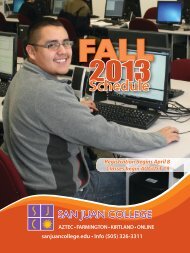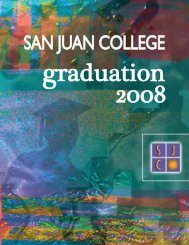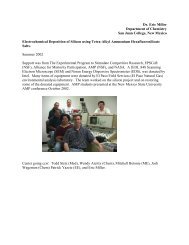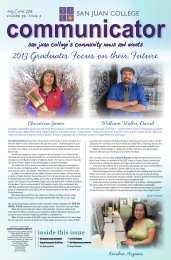AQIP 2007 Systems Portfolio - San Juan College
AQIP 2007 Systems Portfolio - San Juan College
AQIP 2007 Systems Portfolio - San Juan College
You also want an ePaper? Increase the reach of your titles
YUMPU automatically turns print PDFs into web optimized ePapers that Google loves.
<strong>San</strong> <strong>Juan</strong> <strong>College</strong> – <strong>AQIP</strong> <strong>Systems</strong> <strong>Portfolio</strong>- November <strong>2007</strong>committees, student and employer surveys, studentfocus groups, employee climate surveys, communityforums, environmental scanning, and the Community<strong>College</strong> Student Engagement and Noel-Levitzsurveys (see Tables 3.1 and 3.2).5P2 Senior leaders focus on future opportunities andsustaining a learning environment in a variety ofways. SJC actively seeks federal and state grantopportunities such as U.S. Department of EducationTRIO programs and Title III along with New MexicoHigher Education Department awards to improve thelearning environment. The <strong>College</strong> activity seeksarticulation agreements with other undergraduateprograms within New Mexico and across the region.This allows students to stay in the community andearn bachelors and masters degrees on the <strong>San</strong> <strong>Juan</strong><strong>College</strong> campus. The Higher Education Departmenthas determined that general education core coursessuccessfully completed at any regionally accreditedpubic institution of higher education in New Mexicoare guaranteed to transfer to any New Mexico publicinstitution.Active program advisory committees promotepartnerships, state-of-the-art curriculum revision,equipment donations and strong scholarship supportfor students. SJC, along with the SJC Foundation,provide opportunities and professional developmentprograms to ensure and maintain an active learningenvironment. OSS and OOD play key roles inguiding SJC into the future, with respect to exploringnew sources of funding and employee development.Leadership encourages benchmarking best practicesfrom other higher institutions and the private sector.Examples of benchmarking are presented below.OrganizationCommunity <strong>College</strong> ofBaltimore CountyValencia Community<strong>College</strong><strong>San</strong>ta Fe CCTemple <strong>College</strong>LSU Shreveport School ofMedicineJohnson County Community<strong>College</strong>Benchmark PurposeStudent outcomesassessment practices forstudent servicesPlanning, grantsdevelopment, assessment ofstudent outcomes,enrollment management,LifeMap,ABE/GED programAllied health concept ofSimulation CentersRespiratory programAcademic class schedulingand adjunct facultydevelopment programsRio Salado Community Benchmark online learning<strong>College</strong>process and proceduresUniversity of Phoenix Curriculum developmentSteelcase UniversityLearning environmentsTable 5.4 SJC Benchmarking Best Practices5P3 The highest level decisions involve the Presidentand the Vice Presidents. Through a network of teams,taskforces, committees, councils, and advisory groupsrecommendations are developed on a wide variety ofpolicy matters for consideration by the <strong>College</strong>’sexecutives. Operational decision-making takes placeat the division, department or school level. Employeesare empowered to make decisions about everydayprocess improvements and workflow, provided thesedecisions do not impede or have a negative effect onother departments or the institution.SJC leadership has identified the followingframeworks for renewing the Strategic Plan in the<strong>2007</strong>-08 fiscal year: (1) Resource Allocation, (2)Enrollment Growth and Management, (3) Retention ofOur Students, (4) Developmental Education Successand (5) Communication <strong>Systems</strong>. These prioritieshave emerged in light of a pending decrease inenrollment-based state funding in the 2008-09 fiscalyear, findings from a institutional climate survey thatreveal employee concerns about communication anddecision-making, and mounting concern regarding thestate’s and region’s competitiveness in a globaleconomy. These priorities will be addressed throughthe following new task forces:5P4 Prior to making final decisions, SJC’s leadersreview and analyze pertinent information, much ofwhich has been collected and reviewed first throughthe network of groups mentioned above in 5C1 and5P3. The Program Approval Process, for example,requires analytical review of specific stakeholders andemployment information for review prior to approval ordenial of new program requests. The Board ofTrustees has established a policy of periodic review ofacademic programs to determine their financialviability, relevance to labor market needs and studentinterests, and alignment with SJC’s mission. TheLearning Leadership Team under the direction of theVice President for Learning continually monitors thesefactors on a regular basis in carrying out this policy.The Personal Assessment of Campus Environment(PACE) survey of all employees was conducted in theearly spring <strong>2007</strong> to assess the perception of currentprocesses for communicating and providing input intodecision-making (see Results section).5P5 Every student and <strong>College</strong> employee and retireehas an email address automatically generatedthrough OTS. As such, each employee has directaccess to campus wide communications via desktopcomputers. Employees can communicate directly withother individuals or to groups through distribution lists.Formal and informal processes create interlockingrelationships to engender communication betweenand among all institutional levels.<strong>AQIP</strong> Category Five: Leading and Communicating 49



